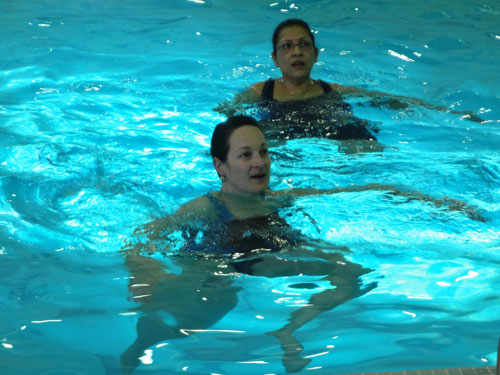
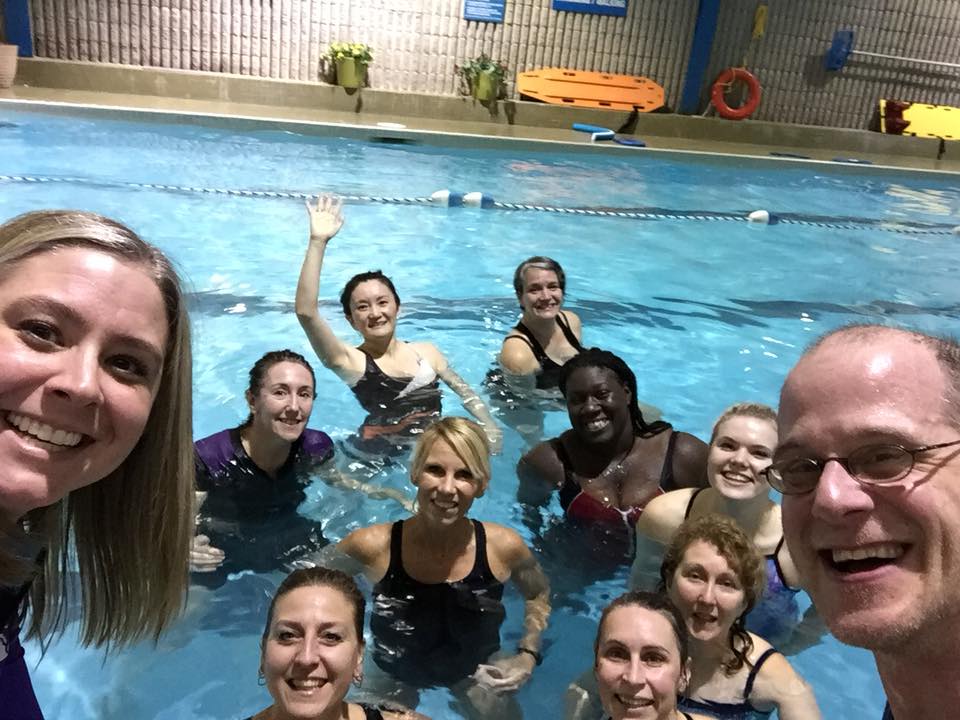
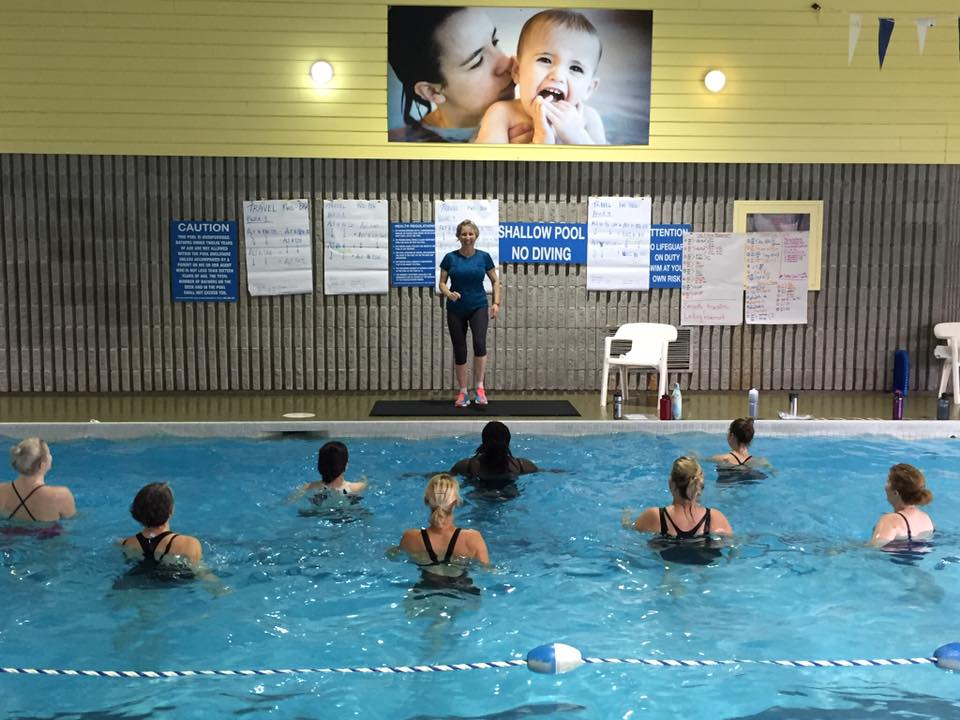
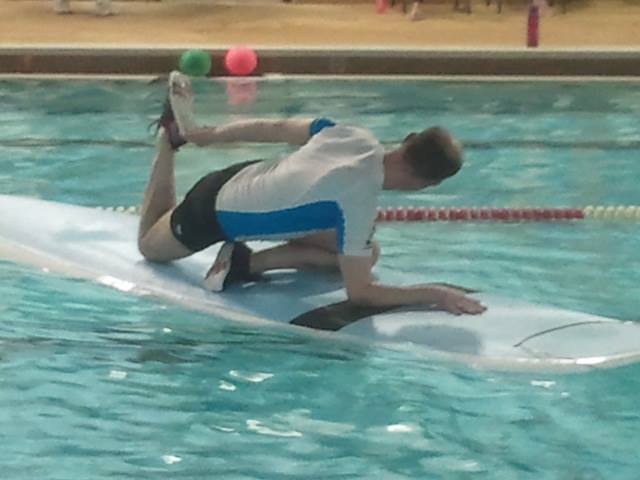
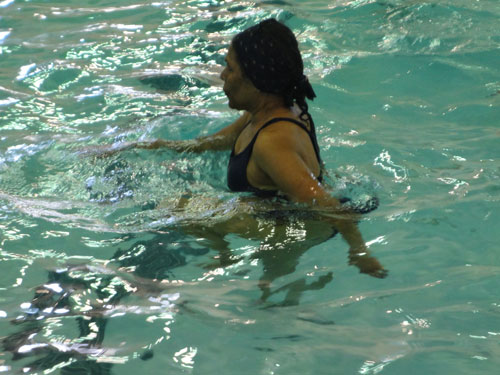
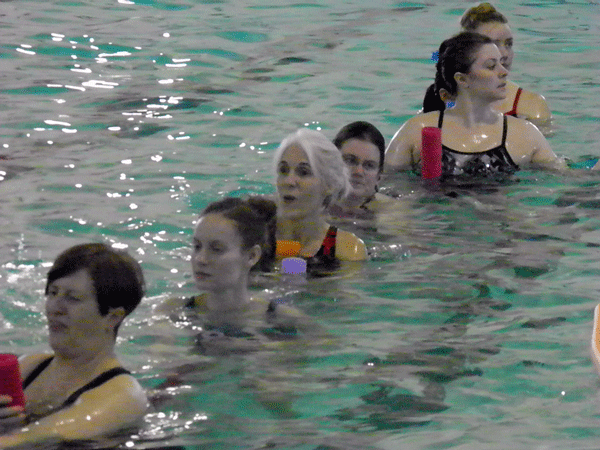 |
Portable Sounds Systems:
Question:
Ask the Seahorse: I am in need of a radio to use on deck but it must be
water/moisture resistance along with the usual CD player, radio, tape.
Can you suggest where I can purchase this item. Someone mentioned to me
that some instructors put rubber stoppers on the connectors or plugs to
protect them...
Answer
Suggestion provided by: CALA
Certified Instructor, Suzanne.. If you inquire at the stores, they’ll
know the best products. In my experience, I’ve used various products—one
huge boom box that was water resistant but eventually failed after years
of use (depends on number classes, moisture in air, must be cleaned
regularly)—one pool was salt water and over the summer months (when we
weren’t there) we found a salt residue on our equipment in the fall when
we returned (so I covered my boom box during subsequent summers)—I’ve
stored smaller boom boxes in a closed container for protection, stored
in locked shed, and this worked— The BEST means of playing music for me
now is my Bose ($300) and ipod ($250) which is portable for all my
classes (no need to plug it in, CDs get scratched and can no longer be
used, so it’s best to download CDs, make playlists on ipod—can delete
songs you don't like, on each CD). The biggest challenge is finding a
boom box that plays an ipod (some instructors use these, and in my
opinion, this is the ONLY way to go), but others use CDs, so I need a
boom box at each of my 7 pools that plays both, and this is sometimes
hard to find. You can also purchase a connector which you can plug into
a boom box and your ipod (if it only plays CDs). With Sony closing its
doors, you might also find some sales right now. Hope this is helpful.
Question:
regarding anaerobic
training in the water: What are the work:rest ratio times? I know for
land, depending it can be 1:3 or 1:4. I was reviewing the deep water
vertical manual and it says in the back 1:3 however I wasn't sure with
venous return and water properties if the ratios changed as compared to
land.
Answer:
I have been promoting
1:6 as a ratio. I hope that helps.
Question:
Wow. So, to
confirm, if the participants are working anaerobically for 30 sec they
rest 3mins. I was thinking a shorter rest time with venous return etc.
Answer:
If you are working to
improve V02max... 1;6 and the interval might be 15 seconds max... max
effort. if you are working to improve LT, then 1:4 might be more
appropriate or 1:3
Question:
I need your advice. In one
of my aqua fit classes, I have 2 participants (different classes) who
are experiencing leg cramps. One participant in particular gets the leg
cramp when she does the standing quadriceps stretch. She says that she
never gets the cramp on land when she does the same stretch but she
always gets a cramp (leg) in water. She has experienced this for the
past few classes so now she does not do this particular stretch. Would
you know why she is getting this cramp and how to avoid it? Thanks,
Pavla (CALA Certified Leader)
Answer:
There are several possible
reasons for hamstring cramps during a quadriceps stretch. I will list
some causes and cautions below, do let me know what works for your
participants, after you suggest the following options.
Firstly, I am assuming you are doing the standing quad stretch, during
the stretch portion at the end of the class.
(a) If the water temperature is on the ‘cool’ side (less than 84° F),
thermal conductivity may cause the hamstring muscle to lose heat. As the
quads are stretched, the hamstrings are activated. If the hamstrings are
too cold, then there is a strong possibility that a cramp will result.
I suggest integrating dynamic stretching of the quad muscles, rather
than a static standing stretch. This will keep the quad and the
hamstring muscles warm and may avoid the cramping.
(b) If the participants have not generated enough heat in their skeletal
muscles during the ‘workout’ phase of the class, then the hamstring
muscles may not be warm enough, when the standing quad stretch is
performed.
I re-iterate the strategy above (a) and also suggest that you consider
educating the two participants (possibly before or after the class)
about how to elevate their body temperature by exercising at a higher
effort level. You can demonstrate options for them to make the workout
harder to generate more kinetic energy resulting in more body heat. *
This is assuming the participants are healthy enough to exercise at an
appropriate level of intensity to generate heat.
(c) Check to be sure that the participants are in a relaxed state of
mind, body and spirit during the stretch. This can be facilitated my
your tone and volume of voice, and the music you use. Remind them to
deep breathe, and especially to relax their fingers and hands, toes and
feet. From time to time, participants try to grip the floor with their
toes and the bottom of their feet. This action might facilitate a chain
of tension through the feet, the calves and then into the hamstring
muscles.
(d) If your participants are having a hard time maintaining their
balance during the standing quad stretch, this might cause the hamstring
muscles to activate involuntarily. Encourage participants to hold on to
the wall or use one hand/arm under water in a sculling action to
maintain balance and to generate heat.
(e) Add a dynamic vertical repeater quad kick/ham curl movement for 16 –
32 repetitions to warm up the muscle pair, then to the standing quad
stretch. Repeat on the other leg.
Charlene Kopansky, CALA Founder and President
Question:
Aqua Running:
I want to know if there is a difference between Aqua Running and Aquajogging.
Is Aqua Running more specific? I know that "to jog" and
"to run" are very different, but, in the water, these
differences may seem superfluous.
Answer by Charlene Kopansky:
When I co-wrote the resource and training manual for this specialty
course, the team of writers decided that both joggers and runners
would benefit from the training effects of exercising in water. To
avoid minimizing the market, we decided to include both 'names' in
the manual. When training in deep water, zero impact, the
biomechanics of running and jogging are very similar. There is no
ground reaction force when running in deep water hence the actual
running form is modified to suit the aquatic environment. The good
news is that the specificity of training remains high, from water to
land. If on the other hand, one is training in chest or shoulder
deep water, there is impact involved and this affects the
biomechanics of water running and aqua jogging. Get into deep water,
with an appropriate flotation belt and try simulating the jogging
action and the running action. How does it feel? What changes did
you make to the biomechanics of your movements? Try the same
experiment in chest deep water. Try running at a race pace, what
happens to the landing phase of your movement?
Question :
I have a degree in Kinesiology. I have never heard of double
positive muscle activation. Could you explain more about it?
Answer from Charlene CALA
Founder and President:
Thanks for reading the articles on our web site. I also have a
degree – Honours Biological Science with my major in Human
Kinetics and a degree in Education. The double positive muscle
activation refers to the following: When immersed to shoulder depth:
performing knee extension and flexion: the quads will activate
concentrically during the knee extension phase; the hamstrings will
activate concentrically during the knee flexion. This is due to the
fact that the 'location of the load changes' - water is all around
the body, you are constantly pushing and pulling it
(multidirectional resistance). The 'nickname' for concentric muscle
action is positive muscle activation. The nickname for eccentric is
negative muscle action. The lack of soreness is because of the
balanced work: double concentric or double positive. While the quads
are working concentrically, on knee extension, the hams are
releasing - getting a fresh blood supply - so the lack of eccentric
is the same as saying double concentric or double positive. Just a
different way of saying the same thing. During our CALA Foundation
Course, we do discuss the lack of eccentric muscle work during most
movements in water.
Response :
No, it still doesn't make any sense, are you talking cardio
component or muscular component? I thought that in order to actually
gain muscle strength, you must have a concentric and eccentric
phase. I also do not understand the reference to a “release of
muscle tension”.
Answer:
A “Double positive” muscle activation isn’t
necessarily the technical terminology for what happens, but it
beats saying “concentric-concentric”.
B Double positive or “concentric-concentric” muscle activation
means that eccentric muscle work is reduced or absent, and
therefore, DOMS is reduced or absent.
C There is a "release of muscle tension" when using the
opposing muscle group. Refer to the work of Dr. Herman Kabat (mid
1950s), based on the work of Dr. Charles Sherrington. Sherrington’s
Laws of muscle activation ‘Reciprocal Innervation / Inhibition”,
states, ”a reflex loop mediated by the muscle spindle cell …causes
one muscle to relax (be inhibited from contracting) when the
opposing muscle (the antagonist) contracts. This allows movement to
occur around a joint. For instance, when the quadriceps muscle
contracts, the hamstring is reciprocally inhibited, thereby allowing
the knee to straighten”. Source: Facilitated Stretching, R. E.
McAtee, HK press 1993. If the antagonist did NOT relax when the
agonist activated to cause movement, we would be constantly tearing
antagonistic muscles, or be locked immobile in isometric cramps.
Re: Your statement: To actually gain muscle strength, you MUST have
a concentric AND eccentric phase. This is not true, otherwise, gains
in strength could not occur in the water, or with hydraulically
braked exercise equipment.
Question
What can be done, when participants concentrate more on
conversation than they do on working out?
Answer
“I have found one solution to participants talking during
class: I have told them to find a place where they have a lot of
room to manoeuver. Once they know the movements, I tell them to
close their eyes and concentrate on that movement and on their
stability. I have found that this makes participants work harder
because they are more aware of when they start to get lazy. Every so
often, they can open their eyes to make sure they are not getting
too close to each other and/or the edges of the pool. This technique
really does make a difference. I have tried it and it works! Not
everyone is closing their eyes when I ask them to. I think that with
time they may get to like the challenge it offers. It may be fear of
the unknown that is holding some of my participants back. My reason
for using this technique for myself was to experience the session
the way a blind person would. I could not believe how much harder I
worked and how aware I was of every movement. Doing this exercise
allows the mind to rest and as a result, tension seems to leave the
body.
Why not try it yourself, then try it with your participants - the
mouth stops, the mind focuses and the physical results are amazing.”
Question
Exercise Design for Breast Cancer:
I have several participants who are recovering from Breast Cancer
treatment that involved varying degrees of tissue removal. The
mobility in the upper body is affected, especially in the shoulder,
upper back, arm and chest regions. What exercises would you
recommend?
Answer
Any and all CALA arm movements are great, since they provide a
variety of joint angles and forces for the arms and shoulder girdle.
Emphasize a 'scapular-set' for all upper body exercise: roll the
shoulders up then back, then down, and fix the scapulae (shoulder
blades) low and centred toward the mid back. This is the strongest,
most functional position for upper body work. The thing that needs
to be emphasized for Breast Cancer clients is FULL range of motion
of the shoulder joint, so the stretch section at the end of class
could be increased if water temperature allows. Do a number of slow
stretches overhead, interspersed with shoulder girdle adduction and
abduction (round the shoulders & rotate the humerus inward, then
pull the shoulder blades together, open the chest, and rotate the
humerus outward by pointing the thumbs back). They could also be
given some extra stretches to be done in the shower. An excellent
one is to stand with your hip next to a wall (your feet parallel to
the wall), and with a straight arm, trace a circle on the wall from
your hip at the front ... all the way overhead...to your hip at the
back. Standing close to the wall is more advanced, standing farther
from the wall is a gentler stretch.
Question:
What kind of quad stretch do you recommend for people with knee
problems? They cannot really bend the knee too much, let alone grab
the ankle.
Answer:
In chest deep water, have the participant stand in a ski
position (one leg forward, one back), then cue the following:
• pull forward with the arms using a unison breast stroke
movement, so the body is balanced over the front leg of the ski
stance,
• lean forward slightly in the torso, and bring the back foot off
the pool floor,
• then, bring that same heel up toward the surface of the water.
No need to hang on to the heel. Note: Buoyancy will help bring the
back leg up toward the surface, stretching the hip flexors and
quadriceps muscles of the back leg.
In deep water:
• get into a ski position and hold this position,
• press front leg up toward the surface & dorsi-flex ankle
(stretching hamstrings, gastrocnemius & soleus of front
leg),
• pull back knee BACK behind hip; back foot up toward surface of
water, stretching quadriceps and hip flexors of the back leg,
• scull with hands and arms to maintain vertical balance. After
~10 - 15 seconds, split the stretch further (open the legs). Repeat
this 2 - 3X before changing sides. Again, no need to hang on to the
back foot. The knee is not in danger of any inappropriate forces.
Question
What does (I am not sure if I remember the term properly)
diastasis recti mean?
Answer:
This is a separation of the rectus abdominis muscles during
pregnancy. The connective tissue running between the two halves of
the rectus muscles softens in response to the hormones of pregnancy
(relaxin). If the abdomen is profoundly stretched, the two halves of
the rectus muscle will tend to take the shortest route when the
rectus abdominis muscles are activated. This means they will tend to
move laterally to travel a straight line from the sternum to the
pubis,and not have to work over the large expanse of the abdomen.
The split can be made worse by doing aggressive abdominal work (ie:
crunches on land) once the split has begun. Aqua natal exercise does
not place the same forces on the rectus muscles, providing
aggressive tucking actions are not performed. Therefore, it is a
useful way for women who are experiencing diastasis recti to
maintain core strength.
|
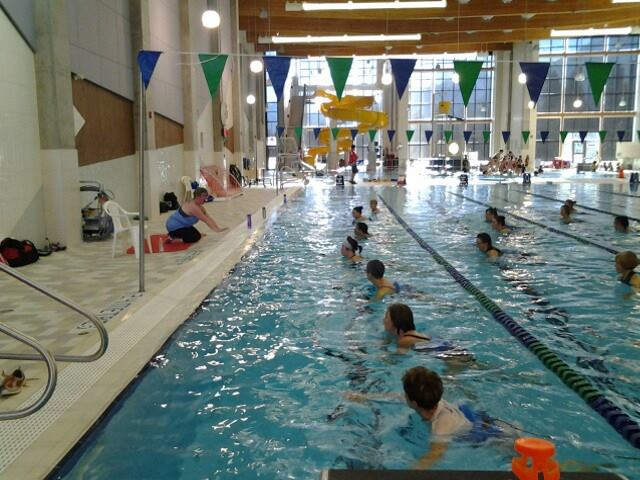
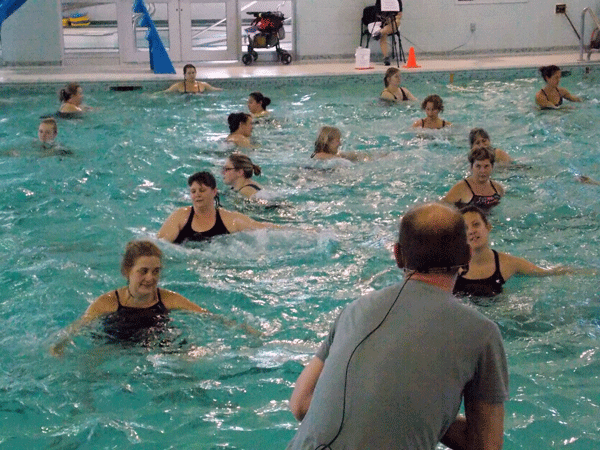
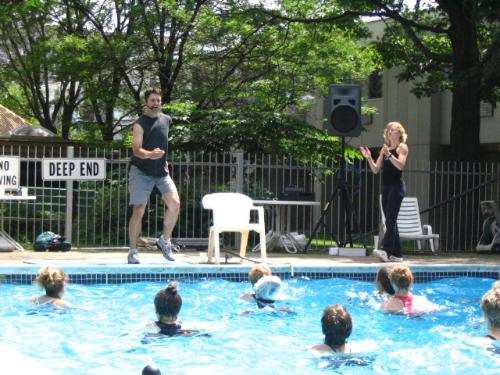
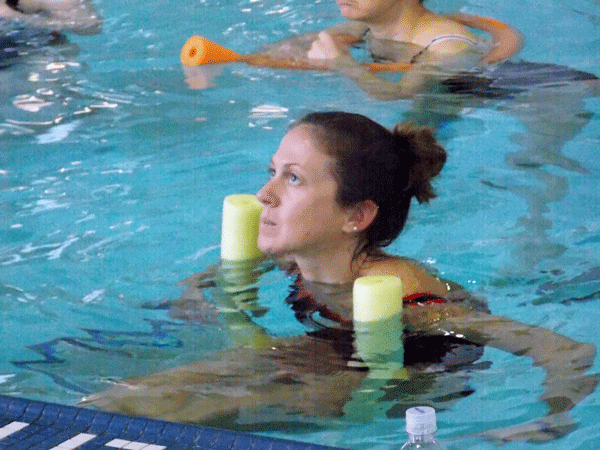
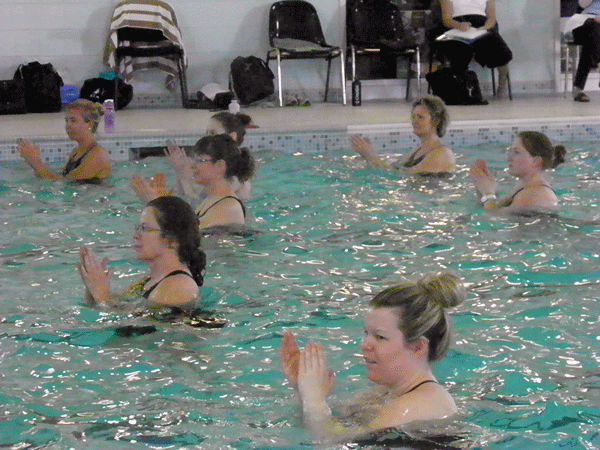
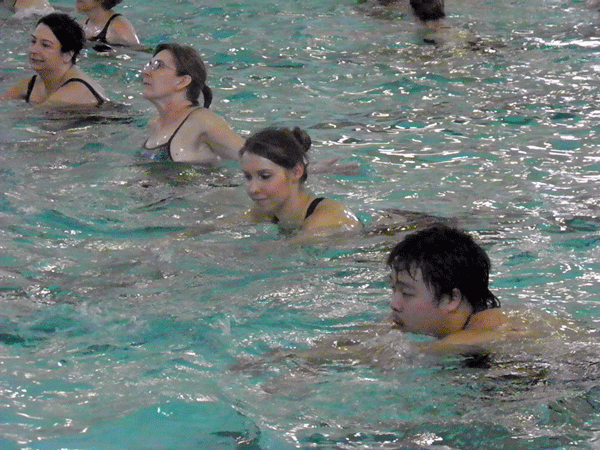 |